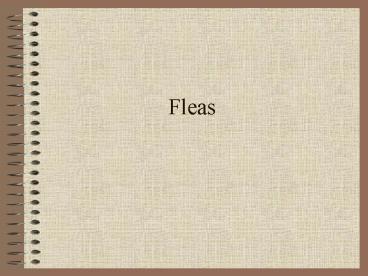Fleas - PowerPoint PPT Presentation
1 / 26
Title: Fleas
1
Fleas
2
Insects as Weapons or "Bug Bombs"
3
What are the possibilities?
- Insects that sting
- Insects that carry disease
- Insects that bite/suck
- Insects that produce toxic substances
- Affect food supply
4
World War II
- Japan and the Pingfan Project
- Plague and fleas
- Mass produced (500 million fleas per year).
- Released fleas from aircraft
- Also developed other insect-vectored
- diseases.
5
Taxonomic classification
- Phylum Arthropoda
- Class Insecta
- Order Siphonaptera
- Genera
- Pulex irritans (human flea) ???,????
- Xenopsylla cheopis ????
- Ctenocephalides canis (dog flea)
- Ctenocephalides felis (cat flea) the most
prevalent of all flea species
6
Host spectrum
- Canids(????), felids(????), humans, calves,
opossums(??), chickens, raccoons(??)(best found
on cats, stray dogs and mongoose??) - Host preferential rather than host specific
7
Geographic distribution
- Worldwide - survive best in humid conditions (90
humidity).
8
Morphology
- Adults - 1.5 to 4 mm long, dark brown,
laterally flattened, wingless, piercing-sucking
mouthparts, genal (on the cheek) and pronotal (on
the posterior border of the 1st thoracic segment)
combs (ctenidia), rounded head
9
(No Transcript)
10
??
11
??????
12
(No Transcript)
13
- ???(Pulex irritans) ????,????????1?????????,???
??? - ????Xenopsylla cheopis ???1?,??????????????????
?,???????
14
- Eggs - about 0.5 mm long, oval, pearly white
(nonfertile females will produce eggs, but they
will be nonviable)
15
(No Transcript)
16
- Larvae - about 6 mm long, maggot-like,
creamy-yellow, 13 segments with bristles on each
17
(No Transcript)
18
- Pupae - with a loosely woven cocoon which
collects debris, about 4 x 2 mm
19
(No Transcript)
20
Life cycle
21
Life cycle (stages)
- Eggs are laid in the hosts bed, den ??, etc.
(called environmental hot spots) or laid on the
host, where they fall off easily because they are
not sticky. - Larvae feed on dry blood, feces, etc. and may
remain in this stage as long as 200 days.
22
- Pupal stage is the most tolerant stage and can
last from 10 days up to 50 weeks as pre-emergent
adult, depending on environmental conditions - Pre-emergent adults are stimulated to emerge by
heat, carbon dioxide, movement (human or pet
activity). Without stimuli, emergence will be
delayed. - Life cycle takes an average of 18-21 days but may
take 20 months or more.
23
Habits
- Life span of adult 1 year, several months when
unfed. - Breeding places Eggs are laid in hostsnest or
even hair. - Feeding The larvae take adult fleas feces and
other organic debris as their food. Both male and
female adults are blood suckers. They have
relative blood preference.
24
Habits
- Thermo-tropism Fleas prefer warmth.
- Seasonal distribution Majority are prevalent
from May to October. - Activity They may jump as far as 30-40 cm and as
high as 20 cm, but their jumping is not
directional. The transmission of flea is
performed only by their host.
25
Fleas and Diseases
- Causes irritation, scratching, restlessness
- Vector of Yersinia pestis (plague)
- Endemic typhus or flea-borne typhus.
- Intermediate hosts of some tape-worm Dipylidium
caninum, Hymenolepis nana.
26
Control
- Eradication of rodents.
- Eradication of fleas by burning, chemicals.
- Personal hygiene, rat-proof buildings, and do not
let dogs and cats come into the houses.































